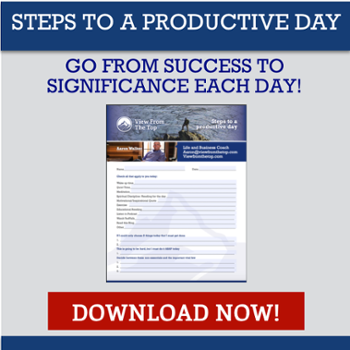
Do you remember that sitcom from the Eighties called “Who’s the Boss?” I used to enjoy that show. It was famous for reversing the roles. Tony Danza played a retired Major League baseball player, who took a job as a live-in housekeeper for Angela, a divorced professional woman.
Well, they ended up becoming an “unofficial family,” and the show was funny because of the constant tension. Tony was constantly changing hats, as the housekeeper one minute and the stand-in “father” for Angela’s family the next. He had to be “the boss” while not actually being “the boss.” That’s what I want to talk about today.
In our online mastermind groups, we’re currently reading a book called “The Ride of a Lifetime” by former Disney CEO Robert Iger. Now, you talk about a position that’ll keep you on your toes! Disney is a Fortune 100 company that operates all over the world. Iger led a group of people the size of some well-known American cities like Madison, Wisconsin or Buffalo, New York.
Michael Eisner
Iger took over from Michael Eisner, who ran Disney from 1984 to 2005. Early on in the book, Iger talks about Eisner’s leadership style. He contrasts it with his own journey, as he goes on to describe leading first at ABC Entertainment, and then Disney.
Eisner made a lot of progress at the helm of Disney. When he took over in the early Eighties, the company was in trouble. The new CEO immediately raised admission prices at their existing parks. He monetized their huge collection of intellectual property by releasing all their movies on VHS. Eventually, Disney moved to building hotels and a cruise line.
As the 1990s arrived and Disney acquired ABC, Iger got more close-up views of Eisner’s ways. He noticed that his boss had an ego-driven need to take credit for things:
In expressing his pride, and reminding people of the details he was focused on, he could be perceived as being petty and small-minded. I once watched him give an interview in the lobby of a hotel and say, “You see those lamps over there? I chose them.” It’s a bad look for a CEO. (I should confess that I’ve caught myself - or have been caught - doing the same thing a few times.
Wow. Me too. We’re all susceptible to pride, especially those of us with “D” personalities on the DISC assessment. I made a note, after reading this, to keep myself accountable to my mastermind groups, so I can avoid doing things like that.
Steve Jobs
Another area Eisner’s leadership failed was the strategic relationship with Steve Jobs and Pixar, the digital movie production company. Does anyone remember Disney’s animated films of the late 1990s and early 2000s? Most of them were flops, with a few exceptions: every time they co-produced with Pixar, they crushed records at the box office.
With each successive movie - Toy Story, A Bug’s Life and Monsters Inc.- Pixar was becoming the new standard in animated films. Steve Jobs wanted to renegotiate the contract, as it became clear what was behind the popularity of the movies. But Eisner refused to update it. By the time Iger succeeded him as CEO, Pixar had broken off the relationship.
Roy Disney
Another influential force Eisner failed to handle well was Roy Disney, Walt’s nephew. He was one of the last remaining members of the Disney family involved in the business. Roy was on the board of directors, and he’d originally campaigned to hire Eisner as their new CEO. But as things deteriorated in the early 2000s, Roy began to call for new leadership.
This led to a sharp, public disagreement. Eisner decided to leverage board rules in 2004 to have Roy Disney retired from the board of directors. He eventually resigned, but that didn’t end the battle. Roy joined forces with Stanley Gold, another unhappy board member who also resigned, and they formed the “Save Disney” campaign.
Well, you can imagine the direction this was going. It wouldn’t be long before these two drove a wedge among the public. There were a lot of reasons for this. But one of them, for sure, was that Eisner wanted more control than he should have expected to get. To a degree, he was treating people around him more like “servants” than “advisors.” He could have used the advice of a business mastermind, and he had one right under his nose.
The Iger Sanction
Iger succeeded Eisner as CEO in 2005. His very first acts in the driver’s seat aimed at undoing the damage Eisner had done in key relationships with Jobs and Roy Disney.
Now, remember, Iger didn’t get this job out of an ad in the paper. He’d been Eisner’s COO. He’d been involved with Disney as a parent company for over a decade. There were probably plenty of instances he could point to where both Jobs and Roy had caused them embarrassment or problems.
Do you see the difference in how Iger thought about it? This wasn’t personal for him, as it had been with Eisner. He understood his role as CEO was to steer a massive company in the right direction, for the benefit of everyone. Executives, directors, shareholders, employees - and especially customers. He leveraged these different interests like a business coach. He listened to their concerns, frustrations and priorities … and proposed a strategy.
You
What’s your need like for recognition and applause? I think it’s worth subjecting this part of yourself to the scrutiny of a mentor, coach or mastermind online. Can you imagine operating a company the size of Disney with your pride as the determining factor for making decisions?
I want to challenge you to set a different course for your business. Whether you’re in start-up or scale-up mode, you have an opportunity to position yourself as an architect. You have to do the hard work of thinking about the right way to handle things. I believe Robert Iger made many successful, positive decisions as CEO of Disney because he’d already spent years making them in his previous roles. But we won’t get good at making the right decisions until we’re open the possibility that the ones we’re currently making are wrong.
So, I invite you to start by recruiting a solid board of directors of your own. At our website, you can apply to join one of our mastermind groups online, and surround yourself with a group of caring, committed and capable leaders.





